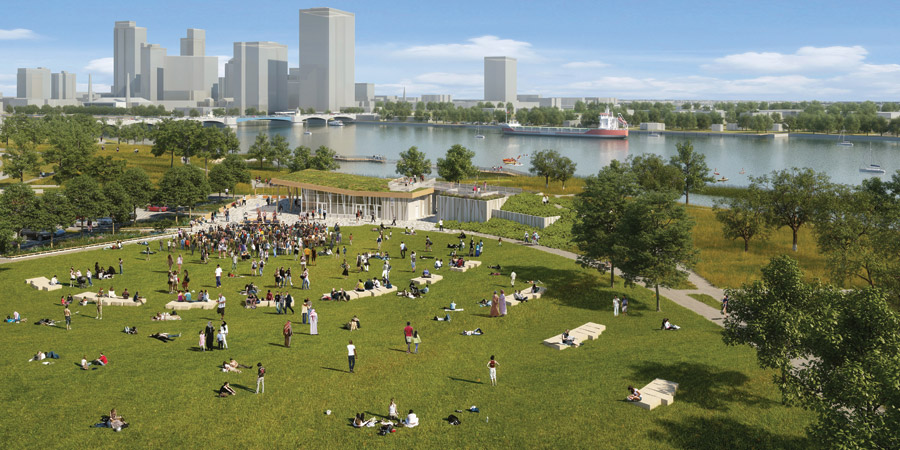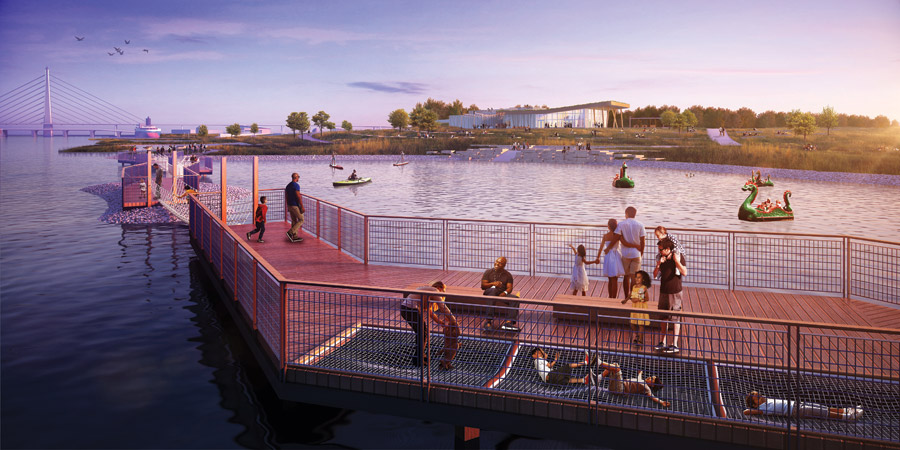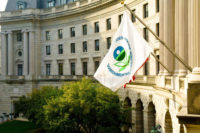Digging Deeper | Landscape/Urban Development
Turning River Land Into 300 Acres of Greenspace

The Glass City River project is turning land along the Maumee River into 300 acres of greenspace.
Photo Courtesy of Toledo Metroparks
For nearly two centuries, the Maumee River was the hub of Toledo’s economy, providing convenient shipping access to the Great Lakes as the cycle of industrial growth and change played out along its banks.
Now, thanks to an ambitious $225-million park development program led by Toledo Metroparks, the river is poised to take on a new role as a unifying element that reconnects the city’s diverse communities with nature and each other.
Launched in 2020 and named in honor of Toledo’s rich history as a center for glass manufacturing, the decade-long Glass City Riverwalk program aims to turn existing brownfields and other underutilized riverfront properties on both sides of the Maumee into 300 acres of greenspace and recreational facilities linked by five miles of multiuse pathways. Funding for the program’s design and construction efforts to date has come from a local property tax levy, philanthropy and government grants.
The first two phases, completed in 2020 and 2023 and totaling $38 million, delivered Glass City Metropark, a 70-acre urban greenspace that also features a 9,500-sq-ft restaurant and support building, a 5,000-sq-ft event facility, nature-themed play areas and a 1,000-ft-long trail for ice-skating and roller-skating called the Ribbon.
Currently, the program’s $58-million third phase, partially funded by a $23-million U.S. Dept. of Transportation BUILD grant, is constructing the first 1.05 miles of the multiuse trail along both sides of the river. Other elements include a scenic cove with river access and a spiral bridge linking new downtown green space to an existing drawbridge. The scheduled completion of this phase at the end of next year will put the program at the halfway mark.
Jennifer Van Horn, Toledo Metroparks’ chief planning and construction officer, says that while public input was critical in shaping the vision for the new parks, collaboration with and among the design and construction teams has made it possible to turn those needs and priorities into reality.
“Working with partners earlier and fast on all the development agreements, right-of-way and utilities has been a critical factor for funding and construction timelines,” Van Horn says. “We have great partners that understand the goal and importance of the project and work with us to make it successful.

Firepits and lighted towers next to the Ribbon, a 1,000-ft-long trail for ice-skating and roller-skating.
Rendering courtesy of Toledo Metroparks
The Making of Metropark
As might be expected given the area’s heavy industrial past, site conditions were hardly ideal for establishing an urban forest and other plantings. Cheryl Zuellig, director of landscape architecture for SmithGroup, lead architect/engineer for the two Metropark phases, explains that the site was rife with industrial fly ash debris. The dearth of organic material required Toledo Metroparks to secure nearly 31,000 cu yd of dredge material to enhance the soil.
“We wanted to be sure that we could put trees in there and they would actually grow,” Zuellig says.
While no major contaminant remediation was necessary, Lathrop, the construction manager at-risk for the Metropark phases, encountered plenty of underground obstructions during excavation, from abandoned foundations and utility structures to more than two dozen “clinkers”—large crucible-shaped hunks of slab metal created during refractory processes.
“Working with partners earlier and fast on all the development agreements, right-of-way and utilities has been a critical factor for funding and construction timelines. We have great partners who understand the goal and importance of the project."
—Jennifer Van Horn, Chief Planning and Construction Officer, Toledo Metroparks
“We were able to incorporate some of them into public art, providing a unique reminder of Toledo’s industrial past,” Zuellig says.
Along with making Metropark suitable for natural features, Lathrop incorporated a multifaceted network of new underground utilities, including irrigation and drainage, conventional building systems for the new facilities and hydronic lines for the Ribbon.
“A lot of coordination had to happen before anything got underway in the field,” says Ryan Gundy, manager of Lathrop’s special projects division. That included mapping out and detailing dozens of connection points.
“If there was a conflict, we had to figure out what could go where or what would be installed first,” Gundy says.
Higher than expected groundwater also complicated installation of a pump house vault to support the Mini Maumee, a scaled-down version of the Maumee River watershed that doubles as a waterfront play area. Additional excavation and installation of sheet pile and a well has enabled the project team to strike a balance of location, aesthetics and operational requirements.
Lathrop operations manager Allen Ziemkiewicz says that along with overcoming the site complexities, the Metropark phases were a safety success, logging 135,000 work hours with no injuries.
“We also did well with sequencing work with the project’s grant funding so that Toledo Metroparks could maximize those resources,” Ziemkiewicz adds.

A glass pavilion—with a rooftop garden and two viewing decks—and the adjacent event lawn were the main elements of Glass City Metropark. The pavilion doubles as an amphitheater when a stage is added, accommodating gatherings such as the Toledo Jazz Festival.
Rendering courtesy of Toledo Metroparks
Down By the Riverside
Project team collaboration would prove instrumental in tackling a similar set of challenges for the initial sections of Riverwalk pedestrian pathways. The conditions of the federal BUILD grant, administered by the Ohio Dept. of Transportation (ODOT), accelerated what might have been a three-year design process into just eight months, according to Mike Gramza, geographic discipline leader for lead A/E consultant Colliers Engineering and Design.
“There was a lot of effort by all the firms to get to that point,” Gramza says, adding that having CMAR contractor Kokosing on board was valuable as well. “We could bounce things off them and look at different ideas as we got information and the design took shape.”
Still, the process was hardly easy, as more information about site conditions and project costs pushed construction estimates well beyond their budgets. Kokosing project manager Kaleb Tobien characterizes the months leading up to the October 2022 construction start as “ongoing value engineering,” with details priced out as soon as drawings were received.
“It was a testament to the team’s effort to revise the scope to everyone’s satisfaction,” he adds.
“We wanted to be sure we could put trees in there and they would actually grow.”
—Cheryl Zuellig, Director of Landscape Architecture, SmithGroup
For example, the original plan to replace seawalls bordering existing riverside pathways were scaled back to retain as many sections as possible. Solutions included reuse of existing sheet piling found to be in good condition and adding lightweight 70-lb-per-cu-ft fill behind the seawall to reduce lateral walls and eliminate the need for heavy steel. One section used tie-backs to steel sheet piling deadman walls, which Gramza likens to “having a seawall protect a seawall.”
As Riverwalk sections are widened and secured, Kokosing is installing two types of distinctive pavement blocks, each containing pieces of clear and colored glass—another nod to Toledo’s glass manufacturing heritage—as well as stainless steel railing with integrated lighting.
Perhaps the most distinctive feature of the initial Riverwalk phase is the Bend Bridge, a 300-ft-long, seven-span spiral structure that rises from a public gathering area to the trail’s west side to the Martin Luther King Bridge, providing access to Toledo’s existing International Park on the east side. The legs of the structure’s V-shaped piers have elliptical cross sections with unique octagonal-shaped rebar, while the bridge deck’s longitudinal bars are bent to match the structure’s curvature.
“We used our in-house form shop and 3D modeling to create custom forms for the structure,” Tobien says. “There was a lot of coordination and early meetings with the design team to optimize the design and use the same geometry.”
Among the coordination needs was development of a straddle bent for one of the piers to safely span a telecommunications duct bank. And in relocating a water line for the bridge, “we found eight other utilities that were not on the plans,” Tobien adds. “Fortunately, only two were active.”

The Adventure Boardwalk, which bridges a cove, is the site of a former marina. It incorporates cargo netting and rope bridges, providing both fishing access and recreational elements along the Maumee River.
Rendering courtesy of Toledo Metroparks
Looking Ahead
While the schedule for transitioning Glass City Riverwalk’s remaining phases from schematics to construction is contingent on funding availability, efforts to date have proven successful, with the new Metropark attracting nearly a half-million visitors since its June 2023 opening. In addition, Toledo Metroparks recently received the Innovation in Park Design Award from the National Recreation and Park Association.


